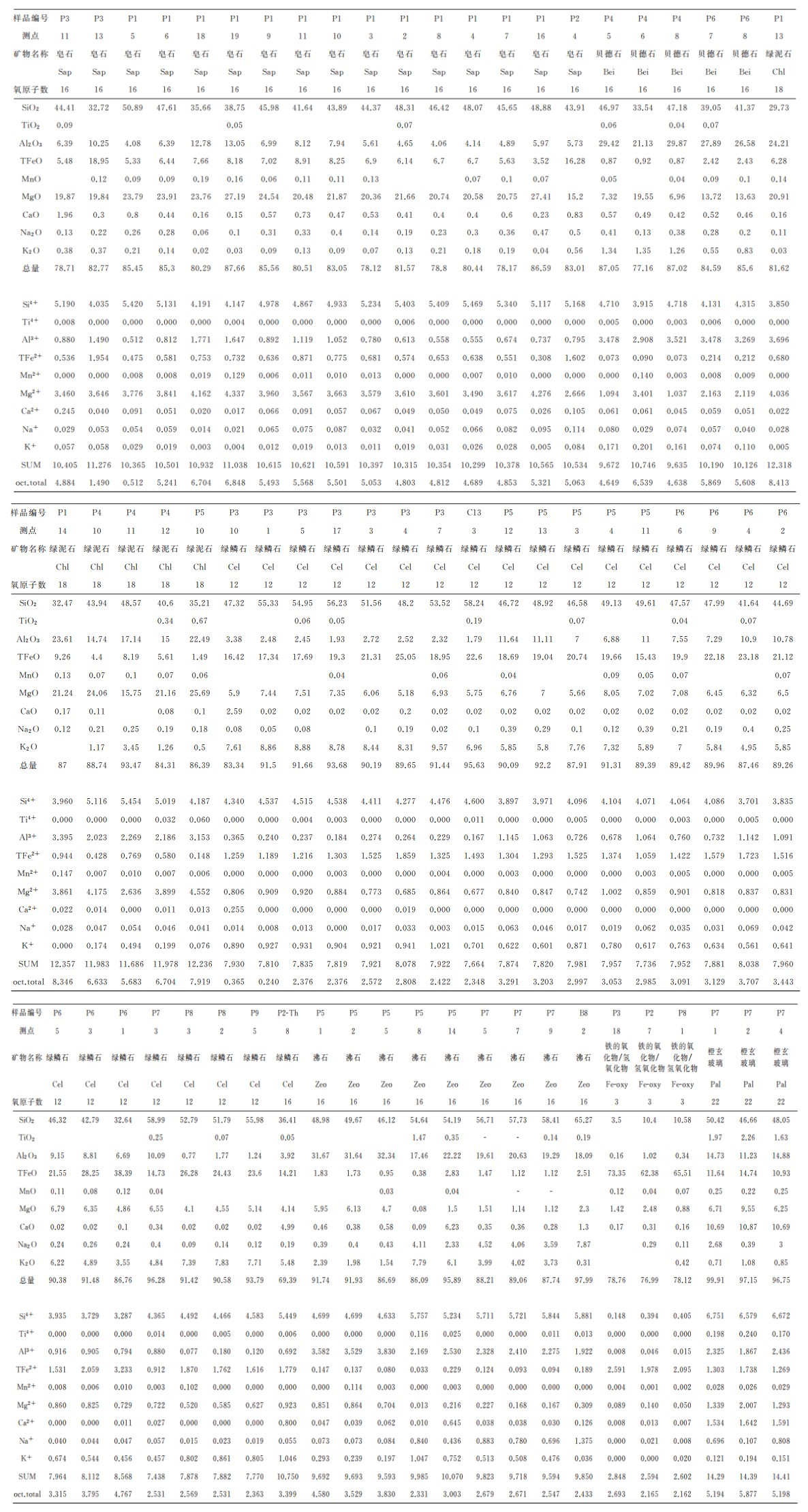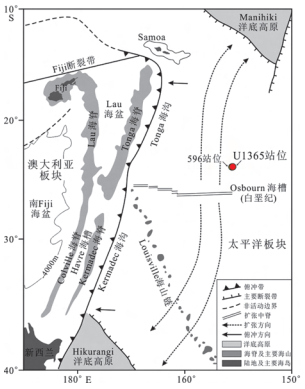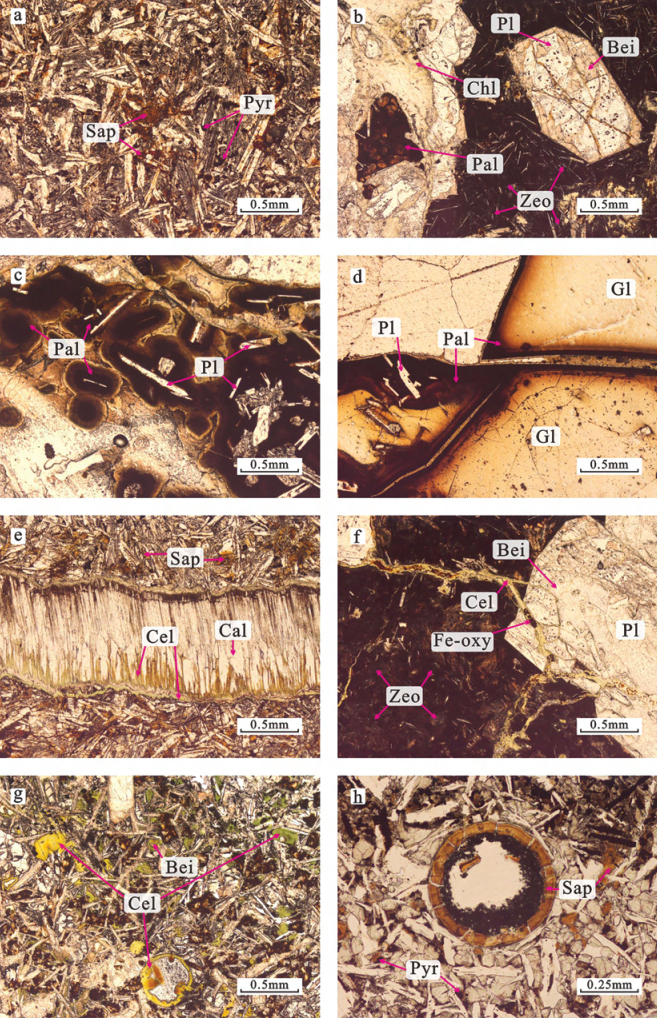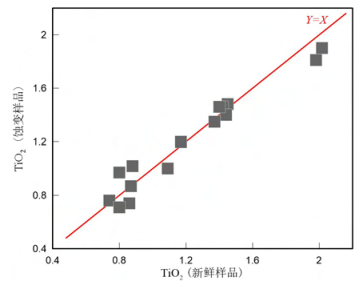Alteration of oceanic crust at the Tonga-Kermadec subduction front and its controlling factors
-
摘要:
蚀变大洋地壳通过俯冲带进入地幔, 是导致岛弧火山作用的重要物质来源。洋壳蚀变导致的矿物和地球化学组成变化对理解固体地球化学循环具有重要意义。IODP U1365站位位于汤加-克马德克俯冲带前缘的俯冲板片上, 对该站位蚀变玄武岩的研究有助于理解汤加-克马德克俯冲带的俯冲过程。对U1365站位的9件玄武岩样品进行了蚀变产物的主量元素电子探针分析, 并结合全岩主量元素含量, 探讨了低温热液蚀变的影响因素及蚀变产物对化学组成变化的控制。研究表明, 该站位的主要蚀变产物为皂石、绿鳞石、贝德石、沸石、绿泥石、橙玄玻璃、黄铁矿、方解石, 以及铁的氧化物/氢氧化物, 为典型的低温热液蚀变产物组合特征。从岩石单元(熔岩流)边界或裂隙边缘到岩石内部, 蚀变矿物呈现铁的氧化物/氢氧化物—绿鳞石—皂石+黄铁矿的带状分布, 指示了从氧化环境向还原环境的转变。该站位的蚀变类型包括矿物置换、气孔填充及裂隙填充。根据蚀变产物组合及矿物穿插关系, 将U1365站位玄武岩的低温蚀变过程划分为4个阶段:玄武质玻璃橙玄化、氧化蚀变矿物(绿鳞石+铁的氧化物/氢氧化物)的形成、还原蚀变矿物(皂石+黄铁矿)的形成, 以及裂隙的封闭。低温热液蚀变过程对该站位玄武岩化学成分的改变主要体现为K2O、Fe2O3含量的升高及FeO、CaO、Na2O含量的降低, 并且在靠近岩石单元(熔岩流)边界的部位, 样品的蚀变程度更高, 所需的最小水岩比更大, 全岩化学组成的改变也更强烈。蚀变产物的电子探针数据分析显示, K2O主要赋存在绿鳞石和沸石中; Fe2O3主要赋存在铁的氧化物/氢氧化物、橙玄玻璃和绿鳞石中; CaO主要赋存于方解石岩脉中, 在其他蚀变产物中含量极低。该结果可用于解释U1365站位蚀变玄武岩的化学组成变化, 如更容易接触氧化性海水的蚀变样品通常表现为氧化型蚀变产物组合(铁的氧化物/氢氧化物、橙玄玻璃、绿鳞石等), 其全岩组成与新鲜样品相比表现出更强烈的K2O、Fe2O3富集, 说明蚀变类型对于大洋玄武岩的化学组成变化有一定的控制作用。
Abstract:Altered oceanic crust is the significant source of the materials subducting into the mantle and cause of volcanisms.The variations in mineral and geochemical compositions that caused by the alterations are crucial for understanding the chemical cycles of the solid earth.IODP Site U1365, located in the subduction slab in front of the Tonga-Kermadec subduction zone, is selected as an ideal place for study of the basalts to reveal the subduction process of the Tonga-Kermadec zone.We analyzed the major elements of alterated products of 9 basalts with electronic probe.Combined with bulk rock geochemical data, we investigated the influencing factors of low temperature alteration, and discussed the control of alteration products on bulk rock geochemical variations.The major products of alteration are recognized as saponite, celadonite, beidellite, zeolite, chlorite, palagonite, phyrite, calcite, and Fe-oxide/hydroxide, which represent a typical type of low-temperature alteration.From the lava boundary and/or vein edge to the center of the rock, aprogressive sequence of dominant secondary mineral assemblage has been identified, which changes from Fe-oxide/hydroxide to celadonite, to saponite+phyrite, indicating a transition from oxidizing condition to reducing condition.The types of alteration include mineral replacement, vent filling, and vein filling.Based on the mineral compositions and intercalating relationships, the alteration processes could be divided into four stages, characterized respectively by palagonitization of basaltic glass, formation of oxidizing minerals (celadonite and Fe-oxide/hydroxide), formation of reducing minerals (saponite and phyrite), and the closing of fractures by calcite veins.The chemical changes of oceanic basalts during the alteration are mainly marked by rising in K2O and Fe2O3, and losing of FeO, CaO and Na2O.The alteration becomes intensified when it closes to the lava boundary, as the minimum water-rock ratio rising up.As the result, it will lead to stronger chemical variations.Electronic Microprobe data analyses show that, K2O is mainly reserved in celadonite and zeonite; Fe2O3in Fe-oxide/hydroxide, palagonite, and celadonite; and CaO in calcite vains but significantly low in other alteration products.This result can explain the chemical variations of the basalts of Site U1365, for instance, the samples, which suffered stronger sea water oxidation, may have more oxydic alteration products (such as Fe-oxide/hydroxide, palagonite, and celadonite) enriched in K2O and Fe2O3, indicating the control of alteration types on oceanic basalt compositions.
-

-
表 1 U1365站位蚀变玄武岩样品
Table 1. Sample list of altered basalts from Site U1365
序号 样品ID 顶深/mbsf 底深/mbsf 薄片编号 对应蚀变全岩样品 1 329-U1365E-3R-3-W 33/37 83.54 83.58 P1 2 329-U1365E-4R-1-W 24/25 85.74 85.75 P2 A4 3 329-U1365E-4R-2-W 137/142 88.24 88.29 P3 A5 4 329-U1365E-7R-3-W 2/4 102.37 102.39 P4 A9 5 329-U1365E-8R-1-W 41/47 105.41 105.465 P5 A11 6 329-U1365E-8R-2-W 117/119 107.07 107.11 P6 A12 7 329-U1365E-8R-4-W 8/10 108.62 108.64 P7 8 329-U1365E-11R-2-W 89/93 117.96 118 P8 9 329-U1365E-12R-3-W 128/132 123.59 123.63 P9 表 2 蚀变产物主量元素的电子探针分析数据
Table 2. Electron probe microanalysisi data of major elements of alteration products

表 3 U1365站位玄武岩蚀变特征
Table 3. Basalts alteration characteristics at Site U1365
薄片编号 位置 蚀变程度 脉体比例% 主要蚀变产物 最小水岩比((W/R)imim) Sap Cel Zeo Bei Pal Fe-oxy Py K Li Rb Ba P1 上部 中 30 20 5 2 2 无 有 P2 上部 轻 5 10 有 有 0.24 -32.58 32.67 601.18 P3 下边界 重 10 15 5 有 无 1.81 160.61 89.10 1269.34 P4 下边界 重 20 2 2 10 5 50 无 无 12.41 14.32 185.28 16375.49 P5 上边界 重 30 2 2 1 2 50 无 无 14.29 94.17 54.79 53103.80 P6 中部 中 <1 10 10 1 2 无 无 1.08 115.28 278.10 2832.03 P7 下边界 中 10 1 5 20 无 无 P8 中部 中 <1 10 10 有 无 P9 下部 轻 <1 5 有 -
[1] Zhang G L, Smith D, Christopher.Seafloor basalt alteration and chemical change in the ultra thinly sedimented South Pacific[J].Geochemistry, Geophysics, Geosystems, 2014, 15 (7) :3066-3080. doi: 10.1002/2013GC005141
[2] Révillon S, Teagle D A H, Boulvais P, et al.Geochemical fluxes related to alteration of a subaerially exposed seamount:Nintoku seamount, ODP Leg 197, Site 1205[J].Geochemistry Geophysics Geosystems, 2007, 8 (2) :Q02014. https://agupubs.onlinelibrary.wiley.com/doi/pdf/10.1029/2006GC001400
[3] Spivack A J, Staudigel H.Low-temperature alteration of the upper oceanic crust and the alkalinity budget of seawater[J].Chemical Geology, 1994, 115 (3) :239-247. https://www.sciencedirect.com/science/article/abs/pii/0009254194901899
[4] Shibuya T, Tahata M, Kitajima K, et al.Depth variation of carbon and oxygen isotopes of calcites in Archean altered upperoceanic crust:Implications for the CO2 flux from ocean to oceanic crust in the Archean[J].Earth and Planetary Science Letters, 2012, 321-322 (1) :64-73.
[5] Schramm B, Devey C W, Gillis K M, et al.Quantitative assessment of chemical and mineralogical changes due to progressive low-temperature alteration of East Pacific Rise basalts from 0to 9Ma[J].Chemical Geology, 2005, 218 (3-4) :281-313. doi: 10.1016/j.chemgeo.2005.01.011
[6] Hunter A G, Kempton P D, Greenwood P.Low-temperature fluid-rock interaction—an isotopic and mineralogical perspective of upper crustal evolution, eastern flank of the Juan de Fuca Ridge (JdFR), ODP Leg 168[J].Chemical Geology, 1999, 155 (1-2) :3-28. doi: 10.1016/S0009-2541(98)00138-7
[7] Staudigel H, Plank T, White B, et al.Geochemical fluxes during seafloor alteration of the basaltic upper oceanic crust:DSDP Sites 417and 418[J].Subduction Top to Bottom, 1996:19-38. https://agupubs.onlinelibrary.wiley.com/doi/abs/10.1029/GM096p0019
[8] Stern R J.Subduction zones[J].Reviews of Geophysics, 2002, 40 (4) :3-1-3-38. http://d.old.wanfangdata.com.cn/NSTLQK/NSTL_QKJJ0232216228/
[9] Hellevang H, Haile B G, Tetteh A.Experimental study to better understand factors affecting the CO2 mineral trapping potential of basalt[J].Greenhouse Gases:Science and Technology, 2017, 7 (1) :143-157. doi: 10.1002/ghg.1619
[10] Browne P R L.Hydrothermal alteration in active geothermal fields[J].Annual Review of Earth and Planetary Sciences, 1978, 6:229-250. doi: 10.1146/annurev.ea.06.050178.001305
[11] Staudigel H, Hart S R, Richardson S H.Alteration of the oceanic crust:Processes and timing[J].Earth and Planetary Science Letters, 1981, 52 (2) :311-327. doi: 10.1016/0012-821X(81)90186-2
[12] Petersen N, Eisenach P, Bleil U.Low temperature alteration of the magnetic minerals in ocean floor basalts[J].Deep Drilling Results in the Atlantic Ocean:Ocean Crust, 1979, 2:169-209. https://agupubs.onlinelibrary.wiley.com/doi/abs/10.1029/ME002p0169
[13] Andrews A.Low temperature fluid alteration of oceanic layer2 basalts, DSDP Leg 37[J].Canadian Journal of Earth Sciences, 1977, 14 (4) :911-926. doi: 10.1139/e77-086
[14] Giorgetti G, Marescotti P, Cabella R, et al.Clay mineral mixtures as alteration products in pillow basalts from the eastern flank of Juan de Fuca Ridge:a TEM-AEM study[J].Clay Minerals, 2001, 36 (1) :75-91. doi: 10.1180/000985501547367
[15] Pichler T, Ridley W I, Nelson E.Low-temperature alteration of dredged volcanics from the Southern Chile Ridge:additional information about early stages of seafloor weathering[J].Marine Geology, 1999, 159 (1-4) :155-177. doi: 10.1016/S0025-3227(99)00008-0
[16] Billen M I, Stock J.Morphology and origin of the Osbourn Trough[J].Journal of Geophysical Research-Solid Earth, 2000, 105 (B6) :13481-13489. doi: 10.1029/2000JB900035
[17] Downey N J, Stock J M, Clayton R W, et al.History of the Cretaceous Osbourn spreading center[J].Journal of Geophysical Research:Solid Earth, 2007, 112 (B4) :1-10. https://agupubs.onlinelibrary.wiley.com/doi/pdf/10.1029/2006JB004550
[18] Taylor B.The single largest oceanic plateau:Ontong JavaManihiki-Hikurangi[J].Earth and Planetary Science Letters, 2006, 241 (3) :372-380. https://www.sciencedirect.com/science/article/pii/S0016703711006533
[19] Hoernle K, Hauff F, van den Bogaard P, et al.Age and geochemistry of volcanic rocks from the Hikurangi and Manihiki oceanic Plateaus[J].Geochimica et Cosmochimica Acta, 2010, 74 (24) :7196-7219. doi: 10.1016/j.gca.2010.09.030
[20] Timm C, Hoernle K, Werner R, et al.Age and geochemistry of the oceanic Manihiki Plateau, SW Pacific:New evidence for a plume origin[J].Earth and Planetary Science Letters, 2011, 304 (1-2) :135-146. doi: 10.1016/j.epsl.2011.01.025
[21] Watts A B, Weissel J K, Duncan R A, et al.Origin of the Louisville Ridge and its relationship to the Eltanin Fracture Zone System[J].Journal of Geophysical Research:Solid Earth, 1988, 93 (B4) :3051-3077. doi: 10.1029/JB093iB04p03051
[22] Koppers A A P, Duncan R A, Steinberger B.Implications of a nonlinear 40 Ar/39 Ar age progression along the Louisville seamount trail for models of fixed and moving hot spots[J].Geochemistry, Geophysics, Geosystems, 2004, 5 (6), doi:10.1029/2003GC000671.
[23] Lonsdale P.A multibeam reconnaissance of the Tonga Trench axis and its intersection with the Louisville guyot chain[J].Marine Geophysical Researches, 1986, 8 (4) :295-327. doi: 10.1007/BF02084016
[24] Timm C, Bassett D, Graham Ⅰ J, et al.Louisville seamount subduction and its implication on mantle flow beneath the central Tonga-Kermadec arc[J].Nature Communications, 2013, 4 (4) :1720. http://www.wanfangdata.com.cn/details/detail.do?_type=perio&id=2f26041dc3d56b28e954a807f4fcf1c4
[25] Divins D L.Total Sediment Thickness of the World's Oceans and Marginal Seas[R].Boulder, CO: NOAA National Geophysical Data Center, 2003.
[26] Zhang G-L, Li C.Interactions of the Greater Ontong Java mantle plume component with the Osbourn Trough[J].Scientific Reports, 2016, 6:37561. doi: 10.1038/srep37561
[27] D'Hondt S, Inagaki F, Alvarez Zarikian C A, et al.Site U1365[J].Proceedings of the Integrated Ocean Drilling Program, 2011, 329. http://d.old.wanfangdata.com.cn/NSTLQK/NSTL_QKJJ0226717074/
[28] Turner S, Handler M, Bindeman I, et al.New insights into the origin of O-Hf-Os isotope signatures in arc lavas from Tonga-Kermadec[J].Chemical Geology, 2009, 266 (3) :187-193. http://www.wanfangdata.com.cn/details/detail.do?_type=perio&id=995135d57ff11673367d4383d1724cf1
[29] Castillo P, Lonsdale P, Moran C, et al.Geochemistry of midCretaceous Pacific crust being subducted along the TongaKermadec Trench:Implications for the generation of arc lavas[J].Lithos, 2009, 112 (1) :87-102. https://www.sciencedirect.com/science/article/pii/S0024493709001194
[30] Bloomer S H, Ewart A, Hergt J M, et al.Geochemistry and origin of igneous rocks from the outer Tonga forearc (Site841) [J].Proceedings of the Ocean Drilling Program.Scientific results, 1994, 135:625-646.
[31] Blanc G, Vitali F, Stille P.Unusual diagenetic alteration of volcanoclastic sediments in the Tonga fore-are:Evidence from chemical and strontium isotopic compositions of interstitial waters[J].Geochimica et Cosmochimica Acta, 1995, 59 (22) :4633-4644. doi: 10.1016/0016-7037(95)00317-7
[32] Hajash A, Archer P.Experimental seawater/basalt interactions:Effects of cooling[J].Contributions to Mineralogy and Petrology, 1980, 75 (1) :1-13. doi: 10.1007/BF00371884
[33] Andrews A J.Saponite and celadonite in layer 2basalts, DSDP Leg 37[J].Contributions to Mineralogy and Petrology, 1980, 73 (4) :323-340. doi: 10.1007/BF00376627
[34] Walton A W, Schiffman P, Macpherson G.Alteration of hyaloclastites in the HSDP 2Phase 1Drill Core:2.Mass balance of the conversion of sideromelane to palagonite and chabazite[J].Geochemistry, Geophysics, Geosystems, 2005, 6 (9) :Q09G19.
[35] 邓海琳, 涂光炽, 李朝阳, 等.水/岩比的地球化学意义[J].矿物学报, 1999 (3) :267-272. doi: 10.3321/j.issn:1000-4734.1999.03.003 http://www.cnki.com.cn/Article/CJFDTotal-KWXB199903002.htm
DENG Hailin, TU Guangzhi, LI Chaoyang, et al.Geochemical significance of water/rock ratios[J].Acta Mineralogica Sinica, 1999 (3) :267-272. doi: 10.3321/j.issn:1000-4734.1999.03.003 http://www.cnki.com.cn/Article/CJFDTotal-KWXB199903002.htm
[36] Summerhayes C P, Thorpe S A.Oceanography:an illustrated guide[M].CRC Press, 1996:165-181.
[37] Alt J, Honnorez J.Alteration of the upper oceanic crust, DSDP site 417:mineralogy and chemistry[J].Contributions to Mineralogy and Petrology, 1984, 87 (2) :149-169. doi: 10.1007/BF00376221
[38] Clayton T, Pearce R B.Alteration mineralogy of Cretaceous basalt from ODP Site 1001, Leg 165 (Caribbean Sea) [J].Clay Minerals, 2000, 35 (4) :719-733.
[39] Rouxel O, Dobbek N, Ludden J, et al.Iron isotope fractionation during oceanic crust alteration[J].Chemical Geology, 2003, 202 (1) :155-182. doi: 10.1180/000985500547043
[40] Zhou Z, Fyfe W.Palagonitization of basaltic glass from DSDP Site 335, Leg 37:Textures, chemical composition, and mechanism of formation[J].American Mineralogist, 1989, 74 (9) :1045-1053. http://d.old.wanfangdata.com.cn/NSTLQK/NSTL_QKJJ027034701/
[41] Staudigel H and Hart S R.Alteration of basaltic glass:Mechanisms and significance for the oceanic crust-seawater budget[J].Geochimica et Cosmochimica Acta, 1983, 47 (3) :337-350. doi: 10.1016/0016-7037(83)90257-0
[42] Staudigel H, Muehlenbachs K, Richardson S H, et al.Agents of low temperature ocean crust alteration[J].Contributions to Mineralogy and Petrology, 1981, 77 (2) :150-157.
-




 下载:
下载:





